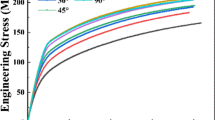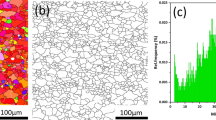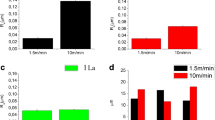Abstract
The effect of the grain orientation on corrosion behavior of rolled AZ31 magnesium alloy is investigated in this study. The test samples have a similar surface roughness to the Mg alloy in practical application. The immersion test and electrochemical impedance spectroscopy show that the TD–ND planes dominated by \((10\bar{1}0)\), \((11\bar{2}0)\) and \((10\bar{1}1)\) oriented grains show a higher corrosion resistance compared with these of the RD–TD planes which consist mainly of (0001) oriented grains. Here, RD, ND and TD represent the rolling direction, the normal direction and the transverse direction of the alloy sheet, respectively. The surface morphologies of the alloys at various immersion stages are observed by scanning electron microscopy, and the surface topography of the alloy substitutes is also observed by laser scanning confocal microscopy. The TD–ND planes show a regular corrosion along the TD direction, but the RD–TD plane shows an irregular corrosion.
Similar content being viewed by others
Avoid common mistakes on your manuscript.
1 Introduction
There have been increasing uses of the magnesium alloys due to their low density, high specific strength and stiffness [1–4]. Rolled AZ31 magnesium alloy exhibits great potential applications in the automobile industry, but the poor resistance to corrosion is one of the major obstacles for its widespread use [5–7].
Rolled magnesium alloy sheet has a strong basal texture and can be adjusted by various processing methods [8, 9]. As is well known, the microstructure has a significant effect on corrosion behavior of the magnesium alloys. So, texture may also play an important role in the corrosion performance of the magnesium alloys. Investigation of the effect law of the texture on corrosion behavior of rolled AZ31 magnesium alloy is necessary for the corrosion behavior modification. Actually the effect of the texture on corrosion behavior of rolled AZ31 magnesium alloy with an ultra-smooth surface has been successfully reported. Xin et al. [10] investigated the influence of the texture on corrosion rate of AZ31 Mg alloy in 3.5 wt% NaCl. They found that the corrosion rate of AZ31 dramatically increased as the (0001) texture intensity decreased and the \(\left( {10\bar{1}0} \right)/\left( {11\bar{2}0} \right)\) texture intensity increased. Song et al. [11] found that the rolling surface of AZ31 alloy mainly consisting of closely packed crystallographic plane (0001) has the lower surface energy and a higher corrosion resistance than that of a cross section surface on which most grains are \(\left( {10\bar{1}0} \right)\) and \(\left( {11\bar{2}0} \right)\) orientated. The surface roughness has a significant effect on the corrosion resistance of metal materials. However, how texture influences corrosion behavior of rolled AZ31 magnesium alloy with a relatively rough surface remains unknown. In practical application, Mg alloy sheet was generally polished by abrasive belt grinding. Most commercially used Mg alloy has a surface with higher roughness compared with the test samples reported in the previous works [10, 11]. The surface topography of the alloy may vary with the immersion time, which may cause the change of the corrosion mechanism. But the surface topography and corrosion mechanism of the magnesium alloy with different grain orientations at various immersion stages have not been sufficiently described.
Hence, the effect of the texture on the corrosion performance of rolled AZ31 magnesium alloy sheet at various immersion stages in neutral 3.5% NaCl solution was studied in this paper. And the test samples have a surface roughness similar to that of practical application.
2 Experiment
2.1 Materials
Commercial rolled AZ31 Mg alloy sheets (Mg—3 wt% Al—1 wt% Zn) are cut into 10 mm (RD) × 10 mm (TD) × 10 mm (ND). RD, ND and TD represent the rolling direction, the normal direction and the transverse direction, respectively. The samples were embedded in resin except the investigated surface (RD–TD or TD–ND plane). All samples were ground with 400-grit SIC paper along TD direction.
2.2 Hydrogen Evolution and Electrochemical Impedance Spectroscopy Measurements
The hydrogen evolution measurements were performed in 250 mL of neutral 3.5% NaCl solution at room temperature. Figure 1 shows the schematic illustration of the hydrogen evolution measurements. The measurements of electrochemical impedance spectroscopy (EIS) (100,000 to 0.1 Hz, 0.005 V, at open-circuit potential) were carried out in situ with a PARSTAT 2273 system after the samples were immersed in 250 mL of neutral 3.5% NaCl solution for 0, 3, 5, 9 and 24 h, respectively. A three-electrode electrochemical cell containing 250 mL of neutral 3.5% NaCl solution was used. A magnesium electrode was used as the working electrode, a platinum electrode was used as the counter electrode, and a saturated calomel electrode was used as the reference electrode.
2.3 Surface Morphology Characterization
The texture components of the samples were confirmed by X-ray diffraction patterns (XRD) using a Rigaku-DMax/2500PC (Japan). The surface morphologies of the samples after being immersed in 205 mL of neutral 3.5% NaCl solution for 1, 5 and 9 h were all observed using a TESCAN VEGA-3 LMH scanning electron microscope (SEM). Then the corrosion product on the magnesium alloy substrate was cleaned by a 200 g/L CrO3 + 10 g/L AgNO3 solution, and the surface topography of the alloy substrate was observed by laser scanning confocal microscopy (LSCM, Olympus OLS4000) subsequently. The surface topography of the samples before the immersion test was also observed by LSCM.
3 Results and Discussion
3.1 XRD Analysis
The texture components of the RD–TD and TD–ND planes are shown in Fig. 2. The RD–TD plane consists mainly of (0001) oriented grains, and the TD–ND plane consists mainly of \(\left( {10\bar{1}0} \right)\), \(\left( {11\bar{2}0} \right)\) and \(\left( {10\bar{1}1} \right)\) oriented grains. Thus, on an ultra-smooth surface, the RD–TD plane consists mainly of the basal planes and the TD–ND plane consists mainly of the cylindrical planes and the pyramidal planes. Figure 3 shows the surface topography of the samples. It can be seen that the surface of the samples is covered over by V-shaped or U-shaped gullies parallel to the TD direction. Thus, the crystallographic planes exposed on the surface of the samples have an enormous difference with that of the Mg alloy sheet with an ultra-smooth surface. The RD–TD plane consists mainly of the cylindrical planes and the pyramidal planes, and the TD–ND plane consists mainly of the basal planes and the pyramidal planes.
3.2 Corrosion Behavior
Figure 4 shows the hydrogen evolution rate curves of the RD–TD and TD–ND planes immersed in neutral 3.5% NaCl solution at room temperature. The two curves are similar in shape. The corrosion rates of them increase with the time in 0–3 h and then decrease sharp from 3 to 5 h as the immersion time goes. Some gases being collected attached to the funnel at intervals, which may contribute to the few unmatched data. In addition, the TD–ND plane shows a better corrosion resistance compared with that of the RD–TD plane.
The magnesium alloy substrate is gradually destroyed when the alloy is immersed into the test solution, leading to the increasing corrosion rate of the alloys in 0–3 h. The reducing corrosion rate after the alloy being immersed for 3 h may be caused by the thickening protective product film. Figure 5 shows the surface morphologies of the corrosion products and the magnesium alloy substitutes at various immersion times obtained by SEM and LSCM, respectively. The area of the product film increases with immersed time, and the surface of the samples is almost completely covered over by the product film at 5 h. Thus, the corrosion rate shows a sharp decrease in a range of 3–5 h and then reduces slowly. On the other hand, the RD–TD plane shows irregular local corrosion, whereas the TD–ND planes show regular corrosion with the etching pits approximately parallel to TD direction instead. The regular corrosion of the TD–ND plane may be attributed to its grain orientation. The sample surface is covered by small gullies parallel to TD direction. There must be a tiny surface parallel to the TD–ND plane in the bottom of the gullies. Due to the \(\left( {10\bar{1}0} \right)\), \(\left( {11\bar{2}0} \right)\) and \(\left( {10\bar{1}1} \right)\) dominated grain orientation on TD–ND plane, the tiny surface in the bottom of the gullies is dominated by the crystallographic planes \(\left( {10\bar{1}0} \right)\), \(\left( {11\bar{2}0} \right)\) and \(\left( {10\bar{1}1} \right)\). However, other areas are dominated by crystallographic planes (0001) and \(\left( {10\bar{1}1} \right)\). A closed-packed plane has a low surface energy, and the metal with a low surface energy has a high corrosion resistance [12, 13]. The crystallographic planes {0001} have the biggest surface atomic density in magnesium alloy. According to Song et al. [11], the theoretical dissolution rates of the crystallographic planes of \(\left( {10\bar{1}0} \right)\) and \(\left( {11\bar{2}0} \right)\) are about 18–20 times higher than those of the crystallographic planes {0001}. So the preferential dissolution occurs under corrosion in the bottom of the gullies which leads to the regular corrosion of the TD–ND plane along TD direction. Thus, a deeper corrosion depth in few areas is also generated on the TD–ND plane compared with that of the RD–TD plane, which can also be found in the surface topography picture shown in Fig. 5.
According to the reported studies [10, 11], the RD–TD plane is more corrosion resistance compared with the TD–ND plane. However, the TD–ND plane shows better corrosion resistance in this study which is opposite to their studies. The different results come from the roughness difference of the samples. In the reported studies, the test samples had ultra-smooth surface. The RD–TD plane consists mainly of the basal planes, and the TD–ND plane consists mainly of the cylindrical planes and the pyramidal planes. So the RD–TD plane has higher corrosion resistance because of the higher corrosion resistance of crystallographic planes (0001). But, the test samples have a relatively rough surface in this study. In the whole immersion process, the alloy substitute of TD–ND sample is consistently covered over by small gullies parallel to the TD direction, implying that the TD–ND plane consists mainly of the crystallographic planes (0001) and \(\left( {10\bar{1}1} \right)\) consistently. As to the RD–TD plane, the alloy substitute is covered over by V-shaped or U-shaped gullies produced during the sample preparation course in the preliminary stage. In the middle and later periods, the gullies produced during the sample preparation course are gradually dissolved and the alloy substitute possesses a surface topography with hilly type. Thus, the RD–TD plane is dominated by the crystallographic planes \(\left( {10\bar{1}0} \right)\), \(\left( {11\bar{2}0} \right)\) and \(\left( {10\bar{1}1} \right)\) consistently. Because of the higher corrosion resistance of the crystallographic planes (0001), the RD–TD plane has a higher corrosion rate compared with that of the TD–ND plane.
These results are confirmed by the electrochemical impedance spectra (EIS) measurement. Figure 6 shows the electrochemical impedance spectra (EIS) curves of the RD–TD and TD–ND planes after immersing for 0, 3, 5, 9 and 24 h, respectively. All of the EIS curves consist of a high-frequency capacitive loop and a relatively small capacitive loop at medium frequency. The high-frequency capacitive loop appears resulting from charge transfer process, and the medium-frequency capacitive loop is related to the relaxation of mass transport in the solid phase, i.e., to the diffusion of ions through the porous solid film on the alloy surface [14–19]. The equivalent circuit of the EIS curves is shown in Fig. 7. Taking account of the non-homogeneity in the system, the constant phase element (CPE) is used instead of capacitance (C) in the equivalent circuit. The high-frequency capacitive loop can be characterized by R t and CPEdl. CPEdl represents the electric double-layer capacity, and R t represents the charge transfer resistance. The medium-frequency capacitive loop is described by the film resistance R f and the film capacity CPEf. R s is the solution resistance.
The EIS fitting results of the RD–TD and the TD–ND planes are listed in Tables 1 and 2, respectively. And the fitting curves are shown in Fig. 6. The fitting curves and the tiny fitting errors prove that the equivalent circuit is suitable. The reciprocal of R t reflects the corrosion resistance of the samples, which is shown in Fig. 8. The RD–TD plane exhibits lower R t value compared with that of the TD–ND plane during the whole immersion process. Both samples exhibit much smaller R t values after immersing for 3 h than that of the samples at the beginning of the immersion test. Then the R t values increase gradually over time, which shows a sharp increase in 3–5 h. The EIS results are highly consistent with the hydrogen evolution rate curves.
4 Conclusions
The effect of the grain orientation on corrosion behavior of rolled AZ31 alloy sheet at various immersion times was investigated. The surface roughness has a big effect on the crystallographic planes exposed on the Mg alloy surface. The RD–TD plane consists mainly of the cylindrical planes and the pyramidal planes, and the TD–ND plane consists mainly of the basal planes and the pyramidal planes on a relatively rough surface. Thus, the TD–ND plane exhibits a better corrosion resistance compared with that of the RD–TD plane because of the higher corrosion resistance of the crystallographic planes (0001). The two planes exhibit that corrosion rate increases with time in 0–3 h and then reduces as the immersion time goes, showing a sharp decrease in 3–5 h. The LSCM results show that the RD–TD plane has an irregular local corrosion, whereas the TD–ND plane has a regular corrosion with the etching pits approximately parallel to the TD direction instead.
References
K. Wen, K. Liu, Z.H. Wang, S.B. Li, W. Du, J. Magn. Alloys 3, 23 (2015)
Y.S. Zou, Y.F. Wu, Y.H. Yang, K. Cang, G.H. Song, Z.X. Li, K. Zhou, Appl. Surf. Sci. 258, 1624 (2011)
H. Zhang, Y. Yan, J.F. Fan, W.L. Cheng, H.J. Roven, B.S. Xu, H.B. Dong, Mater. Sci. Eng. A 618, 540 (2014)
J.E. Gray, B. Luan, J. Alloys Compd. 336, 88 (2002)
G.L. Song, A. Atrens, Adv. Eng. Mater. 5, 837 (2003)
E. Ghali, W. Dietzel, K.U. Kainer, J. Mater. Eng. Perform. 13, 7 (2004)
G.L. Song, A. Atrens, Adv. Eng. Mater. 1, 11 (1999)
S.R. Agnew, M.H. Yoo, C.N. Tome, Acta Mater. 49, 4277 (2001)
W.J. Kim, S.I. Hong, Y.S. Kim, S.H. Min, H.T. Jeong, J.D. Lee, Acta Mater. 51, 3293 (2003)
R.L. Xin, B. Li, L. Li, Q. Liu, Mater. Des. 32, 4548 (2011)
G.L. Song, R.J. Mishra, Z.Q. Xu, Electrochem. Commun. 12, 1099 (2010)
D. Abayarathna, E.B. Hale, T.J. O’Keefe, Y.M. Wang, D. Radovic, Corros. Sci. 32, 775 (1991)
U. König, B. Davepon, Electrochim. Acta 47, 149 (2001)
Y.B. Ma, N. Li, D.Y. Li, M.L. Zhang, X.M. Huang, J. Power Sources 196, 2346 (2011)
L.L. Gao, C.H. Zhang, M.L. Zhang, X.M. Huang, N. Sheng, J. Alloys Compd. 468, 285 (2009)
M. Anik, G. Celikten, Corros. Sci. 49, 1878 (2007)
G. Galicia, N. Pébère, B. Tribollet, V. Vivier, Corros. Sci. 51, 1789 (2009)
X.W. Guo, J.W. Chang, S.M. He, W.J. Ding, X.S. Wang, Electrochim. Acta 52, 2570 (2007)
N.G. Wang, R.C. Wang, C.Q. Peng, Y. Feng, B. Chen, Corros. Sci. 64, 17 (2012)
Acknowledgments
This work was financially supported by Fundamental Research Funds for the Central Universities (No. CDJZR14130009), Scientific and Technological Project of Chongqing Science and Technology Commission (No. CSTC2012GGB50003) and Demonstrative Project of Chongqing Science and Technology Commission (No. CSCT2014FAZKTJCSF50004).
Author information
Authors and Affiliations
Corresponding author
Additional information
Available online at http://springerlink.bibliotecabuap.elogim.com/journal/40195.
Rights and permissions
About this article
Cite this article
Zhao, YC., Huang, GS., Wang, GG. et al. Influence of Grain Orientation on the Corrosion Behavior of Rolled AZ31 Magnesium Alloy. Acta Metall. Sin. (Engl. Lett.) 28, 1387–1393 (2015). https://doi.org/10.1007/s40195-015-0337-2
Received:
Revised:
Published:
Issue Date:
DOI: https://doi.org/10.1007/s40195-015-0337-2












